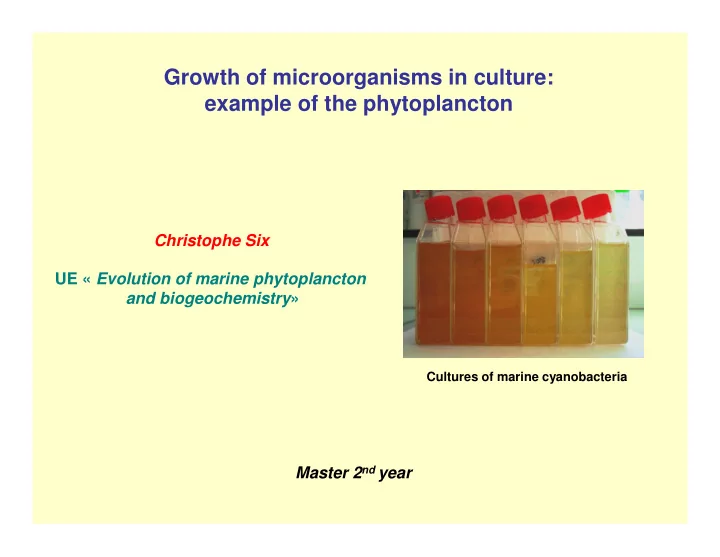

Growth of microorganisms in culture: example of the phytoplancton Christophe Six UE « Evolution of marine phytoplancton UE « Evolution of marine phytoplancton and biogeochemistry » Cultures of marine cyanobacteria Master 2 nd year
What is growth? Any increase of the biomass of an organism Higher organisms Microorganisms Can also be the increase of the size of the population of an organism Why should we measure growth? . Ecology: Prey/predator, adaptation… . Evolution : The key of the Natural Selection of Species . Physiology: Integration of the efficiency of all cell processes
How to measure the growth of a phytoplankton culture ? Monitor the number of cells in the culture function of time - Counting slides (Malassez, Thoma, etc …) 250 µm 250 µm 200 µm 200 µm 50 µm = 0,01 mm 3 = 0,01 µL = 10 -5 mL
- Cell counter (type Wallace H. Coulter) Detection of conductance of the electrolyte
- Flow cytometry
How to measure the growth of a phytoplankton culture ? Monitoring a parameter that varies proportionally to the cell density - Absorption of non-pigmented material (OD 750 nm) - Photosynthetic pigments But be careful to acclimation ! - Concentration of elements (C, N) 1 0,9 0,8 0,7 Absorbance (UA) 0,6 Chl a 0,5 0,4 Non pigmented material 0,3 0,2 0,1 0 400 450 500 550 600 650 700 750 800 Longueur d'onde (nm)
Growth in continuous culture: Turbidostat Culture medium Peristaltic pump Sampling The culture is constantly diluted Trash Culture - Constant volume of culture - Constant cell density - Constant growth rate - No limitation
Growth in closed medium ‘batch cultures) Cell density Time Latence Exponentielle Transition Stationnary Decreasing phase phase phase phase phase Growth is limited by the capacities of the culture medium
Latence phase Cellules - All transferred cells are not viables Temps - Abrupt medium change = stress � � � � ajustment of the physiology to the new medium -The duration and dynamics of the latence phase is often dependent on the mother culture Cellules Culture mère Temps Cultures filles
The exponential phase of growth Cellules Binary division Temps 1 t 1 2 t 2 4 t 3 8 t 4 Cells Time 8 cells 4 2 1 0 1 2 3 4 Time
The exponential phase of growth Cell density N = N 0 . e kT N 0 K : growth constant Time (= growth rate µ µ ) µ µ Cell density ln(N 2 ) – ln (N 1 ) N 2 K = t 2 – t 1 N 1 t 1 t 2 Time
The exponential phase of growth Generation 0 1 2 . Generation / doubling time t g or t d : 3 The time necessary for a cell to divide t g = ln(2) / k . Number of divisions per day n : n = 1/ t g => n = k / ln(2) Generation time t g = 1 day n = 1 division per day ! Growth rate K = 0,69 jour -1
The stationnary and decreasing phases Cells Time - Change of the physiology of the cells in response to the limitation � Resistance - Dynamics of these phases mal connue k Cells Cells k Time Time
Measuring a growth rate experimentally . Estimation from two time points Time (day) 8 9 10 11 12 0 1 2 3 4 5 6 7 cell/mL 1 849 596 960 232 1 235 454 2 001 565 2 945 654 5 621 245 10 236 458 20 804 561 26126876 29463189 30109473 30533249 28112286 35 000 000 ln(N 2 ) – ln (N 1 ) 30 000 000 ion K = K = Cell concentratio t 2 – t 1 25 000 000 N 2 20 000 000 15 000 000 ln(26126876) – ln (5621245) K = 10 000 000 N 1 8 – 5 5 000 000 t 1 t 2 0 0 5 10 15 K = 0.5121 Time
Measuring a growth rate experimentally . Estimation from a natural logarithm regression ln(N) – ln (N 0 ) = > ln(N) = kt + lnN 0 K = t Slope of the regression Time (day) 8 9 10 11 12 0 1 2 3 4 5 6 7 cell/mL 1 849 596 960 232 1 235 454 2 001 565 2 945 654 5 621 245 10 236 458 20 804 561 26126876 29463189 30109473 30533249 28112286 Ln (Cell/mL) 14,4305 Ln (Cell/mL) 14,4305 13,7749 13,7749 14,02695 14,50944 14,02695 14,50944 14,89584 15,54206 16,14147 14,89584 15,54206 16,14147 16,85068 16,85068 17,07848 17,07848 17,19865 17,19865 17,22035 17,22035 17,23433 17,151717 17,23433 17,151717 20 20 35 000 000 Ln (Cell concentration) Ln (Cell concentration) y = 0,5617x + 12,8 30 000 000 18 18 Cell concentration 2 = 0,9904 R 25 000 000 16 16 20 000 000 15 000 000 14 14 10 000 000 12 12 5 000 000 10 0 10 0 5 10 15 0 2 4 6 8 0 5 10 15 Time Time (day)
Exercise: The influence of light on the growth of a cyanobacterium Synechococcus sp. WH8102 15 25 50 85 200 700 µmol photons . m -2 . s -1 Strain isolated from oligotrophic waters
Exercise: The influence of light on the growth of a cyanobacterium What is the impact of light irradiance on the growth of Synechococcus sp. WH8102 ? Experimental protocole : - The cultures were transferred at low cell density - The number of cells was determined by flowr cytometry for several days . Plot the growth curves . Calculate the growth rates ( µ = k), nber of divisions/day (n), Doubling time (t g ) . Plot the curve showing the evolution of the 3 parameters in function of light irradiance
Recommend
More recommend